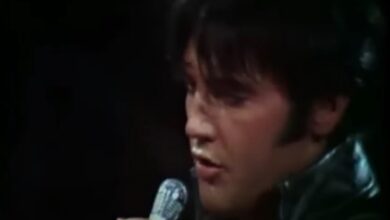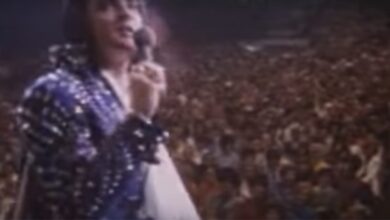Do You Now Recall This Famous 1950s Dance?
In February 1958, a vibrant dance craze swept across American high school gyms and sock hops, capturing the exuberance of the era and embodying the carefree energy that surrounded the early days of rock ‘n’ roll. This dance was none other than “The Stroll,” a line dance that quickly became synonymous with youthful fun, freedom, and spontaneity. Originating primarily in African American communities, “The Stroll” gained widespread popularity through its compelling presence on television, particularly on Dick Clark’s “American Bandstand.” This influential show allowed teenagers from coast to coast to witness the dance, prompting many to eagerly embrace it at their own local gatherings and parties.
The essential structure of “The Stroll” involved two lines of dancers facing each other, creating an aisle down the middle. Couples would take turns strutting down this aisle, showcasing their moves to the rhythm of the music. Each dancer added their own personal flair to the routine, transforming the legato simplicity of the dance into a medium of self-expression. This balance between group participation and individual creativity resonated deeply with the youth of that era, who were increasingly eager to assert their identities in a rapidly changing social landscape filled with shifting norms and burgeoning cultural movements.
Accompanying this lively dance was the catchy tune “The Stroll,” performed by the Canadian vocal group The Diamonds. Renowned for their smooth harmonies and engaging doo-wop style, The Diamonds played an instrumental role in popularizing “The Stroll” and bringing it to a broader audience. Their rendition was more than just another song; it became the anthem for a cultural movement, encapsulating the joy and rebellious spirit of the time. The group’s lead singer, Dave Somerville, known for his rich baritone voice, lent a melodic quality to the recording that became synonymous with this dance craze, guiding budding dancers through the rhythms with his infectious crooning.
The phenomenon of “The Stroll” quickly turned into a staple at social events across the United States. Beyond its immediate appeal, the dance represented a bridging of racial and social divides that characterized the 1950s, a decade marked by considerable segregation and racial tension. The accessibility of “The Stroll,” along with its inherent coolness, attracted teenagers from various backgrounds. They flocked to dance floors in their finest outfits, eager to participate in trend-setting movements that spotlighted their youthful exuberance, marking a moment of optimism and a shared cultural experience in post-war America.
As the popularity of “The Stroll” surged, it became emblematic of a generation’s desire to express themselves freely and embrace the newfound liberties available in the 1950s. The dance’s frequent appearances on television and its prominence in the music scene solidified its status in American pop culture, making it a memorable aspect of the era’s social fabric. The collective joy experienced through “The Stroll” highlighted the ability of music and dance to bring diverse groups of people together, weaving a tapestry of shared experiences and lively celebrations.
In the backdrop of this cultural phenomenon was Dave Somerville, whose contributions to The Diamonds cannot be overstated. Born on July 2, 1933, in Toronto, Canada, Somerville’s passion for music became evident at an early age. He developed a keen interest in harmonies and vocal performances, which ultimately led to the formation of The Diamonds in 1953. With his outstanding vocal abilities and engaging stage presence, Somerville helped define the sound that would lead to the group’s wide acclaim. Their success, particularly with “The Stroll,” cemented his legacy as a prominent figure in the doo-wop movement.
Throughout the 1950s, The Diamonds released numerous hits that captured the zeitgeist of the time. Their music was not merely entertainment; it served as a soundtrack for a generation navigating the complexities of post-war America. The joyful rhythms and relatable lyrics appealed to youth, creating a connection that fostered community and belonging. Somerville’s smooth baritone provided a comforting yet exhilarating presence, cherished by young listeners who sought to channel their energy and aspirations through dance.
The dance itself, beyond being a popular fad, represented a crucial moment in American history, one that acknowledged the importance of youth culture and self-expression. “The Stroll” encouraged teenagers to let loose, celebrate spontaneity, and form connections while dancing. The lining up of couples reflected the vibrant spirit of community common in high schools and social gatherings, emphasizing the excitement of coming together in celebration of music and movement.
Even decades later, the legacy of “The Stroll” and the contributions of The Diamonds remain evident in today’s culture. The upbeat and charming characteristics of the dance endure, serving as a reminder of a simpler time when music dictated the rhythms of youth life. In a world where individual expression has only become more profound, “The Stroll” paved the way for future dance crazes, highlighting the continuous evolution of musical expression.
In conclusion, “The Stroll” encapsulated not just a moment in time, but a cultural movement characterized by youthful exuberance, creativity, and a desire for connection. With influences felt in various aspects of American culture, the dance and the accompanying song by The Diamonds remain a cherished embodiment of the spirit of the 1950s. It stands as a testament to the power of music and dance in shaping social interactions, bridging divides, and fostering community among the exuberant youth of an ever-evolving nation.
?si=CbHsPwTM-VodZAIG





